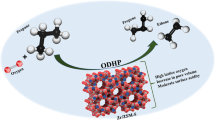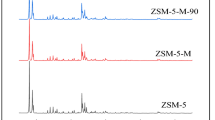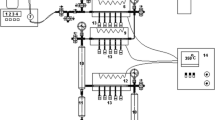Abstract
In this work, we studied the conversion of ethanol to propylene over ZSM-5 zeolites. The catalytic performance of H-ZSM-5 (Si/Al2 = 30, 80, and 280) and ZSM-5 (Si/Al2 = 80) modified with various metals was investigated. H-ZSM-5(Si/Al2 = 80) afforded high propylene yield, which indicates that a moderate surface acidity favored propylene production. Zr-modified ZSM-5(80) gave the highest yield (32%) of propylene at 773 K. Furthermore, the catalytic stability of the zeolite was improved by the modification of zirconium. The surface acidity and the presence of metal ions played important roles on the production of propylene.
Similar content being viewed by others
Explore related subjects
Discover the latest articles, news and stories from top researchers in related subjects.Avoid common mistakes on your manuscript.
1 Introduction
Propylene is one of the most important starting materials for the synthesis of chemicals, such as propylene oxide and polypropylene, and the demand for propylene is growing faster than that for ethylene. Propylene is usually produced by steam thermal cracking of naphtha. The production of propylene has been extensively studied in recent years, because the supply of the petroleum is limited. Ethanol can be produced from renewable sources such as biomass by fermentation. If ethanol could be directly converted to propylene, polypropylene could be manufactured from biomass, and the use of such a process would reduce petroleum dependence and carbon dioxide emissions.
Methanol can be converted over ZSM-5 zeolites to gasoline and light olefins such as ethylene and propylene [1–3]. The product distribution depends on the structure and the acidity of the zeolites and on the reaction conditions. Particularly, light olefins can be produced more selectively from methanol over SAPO-34, a small-pore silicoaluminophosphate [3]. The conversion of ethylene to propylene has also been investigated over SAPO-34 and Ni-containing MCM-41 catalysts [4, 5]. But the catalytic activity and the stability of these catalysts are insufficient for industrial processes. Besides, many literatures reported the conversion of ethanol to hydrocarbons over ZSM-5 [6–16]. However, much attention has been paid to mainly synthesize ethylene, gasoline, or aromatic hydrocarbons from ethanol, there are few reports concerning the ethanol-to-propylene (ETP) process [17]. Thus, this work concentrated on studying the direct conversion of ethanol to propylene over unmodified H-ZSM-5 and metal-modified ZSM-5. The effect of surface acidity and metal ions on the production of propylene was investigated.
2 Experimental
2.1 Catalyst Preparation
NH4-ZSM-5 zeolites (CBV3024E, CBV8014 and CBV28014) with Si/Al2 ratios of 30, 80, and 280 were obtained from Zeolyst. The H-ZSM-5 zeolites were prepared by calcination of the as-received zeolites at 813 K in air for 4 h. The metal-modified ZSM-5(80) samples were prepared by an ion-exchange method and an impregnation method, described below.
The ion-exchange method was used to prepare the zeolites modified with Mg, Ca, Ba, Cr, Mn, Fe, Co, Ni, Cu, Zn, Ga, Ce, Ag, and Pd. The following precursors were used: Mg(NO3)2·6H2O, Ca(NO3)2·4H2O, Ba(NO3)2, Cr(NO3)3·9H2O, Mn(NO3)2·6H2O, Fe(NO3)3·9H2O, Co(NO3)2·6H2O, Ni(NO3)2·6H2O, Cu(NO3)2·6H2O, Zn(NO3)2·6H2O, Ga(NO3)3·nH2O, Ce(NO3)3·6H2O, AgNO3, and Pd(NO3)2·nH2O. NH4-ZSM-5(80) powder was added to a 0.01 M aqueous solution of the metal precursor (3 g powder per 200 ml solution), and the mixture was stirred at a constant temperature of 353 K for 12 h. The resulting mixture was filtered, and the precipitate washed three times with water, dried at 373 K for 12 h, and calcined at 813 K in air for 4 h. The metal contents of ion-exchanged samples were not analyzed.
The impregnation method was used to prepare ZSM-5(80) modified with Bi, Ti, V, Zr, Mo, and W. The following precursors were used: Bi(NO3)3·5H2O, (C4H9O)4Ti, NH4VO3, ZrO(NO3)2·2H2O, (NH4)6Mo7O24·4H2O, and (NH4)10W12O41·5H2O. NH4-ZSM-5(80) powder (3 g) was suspended in a 40 ml solution of the metal precursor (the molar ratio of metal to Al was 0.4), and the suspension was slowly evaporated in a rotary vacuum evaporator at 323 K. Then the residue was dried at 373 K for 5 h and calcined at 813 K in air for 4 h. For Bi(NO3)3·5H2O, the salt was dissolved in water containing enough dilute HNO3 to bring the pH of the solution to 1.0. For (C4H9O)4Ti, the salt was dissolved in 2-propanol; then NH4-ZSM-5(80) was introduced with stirring, and water was added to the mixture.
2.2 Catalytic Testing
Catalytic reactions were carried out in a fixed-bed, continuous-flow reactor equipped with a quartz tube (inner diameter 6 mm) at atmospheric pressure. In a typical run, 0.2 g of catalyst was placed in the central zone of the reactor. A thermocouple reaching into the center of the catalyst bed was used to measure the temperature during the reaction. The catalyst was activated at 773 K for 1 h in flowing nitrogen before reaction. Ethanol (Wako, purity > 99.5%) was pumped into the vaporizer and mixed with N2 at a total flow rate of 25 ml min−1 (P C2H5OH = 20 kPa). The products were analyzed on-line with gas chromatographs (Shimadzu GC-14) equipped with a flame ionization detector and thermal conductivity detectors. An InertCap 1701 column was used to detect ethanol, diethyl ether, and hydrocarbons. A Gaskuropack-54 column was used to detect N2, H2O, ethanol, diethyl ether, and hydrocarbons.
2.3 Catalyst Characterization
NH3-temperature-programmed desorption (TPD) was performed in a flow system (BEL-CAT-32). The catalyst sample (0.1 g) was placed in a small quartz tube and heated at 773 K in a He flow (30 ml min−1) for 1 h. The sample was cooled to 373 K, and NH3 adsorption was performed under a flow of 5 vol% NH3/He (30 ml min−1) for 1 h. The sample was flushed with He gas at a rate of 30 ml min−1 for 1 h to remove NH3 that was physically adsorbed on the sample surface. The desorption of ammonia was measured at a constant heating rate of 10 K min−1 up to 873 K. A thermal conductivity detector was used for monitoring the ammonia desorption.
3 Results and Discussion
H-ZSM-5 and the modified ZSM-5 catalysts showed 100% conversion of ethanol at temperatures above 673 K. Therefore, we carefully investigated the selectivity of the catalysts that is the product distribution.
3.1 Conversion of Ethanol Over H-ZSM-5 Zeolites
Table 1 shows results for catalytic conversion of ethanol over H-ZSM-5 (Si/Al2 = 30, 80, and 280) at 673 K. The product distribution depended strongly on the Si/Al2 ratio. At Si/Al2 = 30, the product mixture consisted of 10.9% propylene, 7.0% ethylene, and 42.4% other products such as paraffins, C5+ aliphatics and aromatics. In contrast, at Si/Al2 = 280, the main product was ethylene (90.7%), and only a small amount of propylene was obtained (3.2%). The highest yield of propylene (16.9%) was obtained with H-ZSM-5(80). The NH3-TPD profiles of H-ZSM-5(30, 80, and 280) are shown in Fig. 1. All the samples showed two desorption peaks, one centered at 473 K and the other at 673 K, corresponding to the weak and strong acid sites, respectively. Increasing the Si/Al2 ratio clearly reduced the surface acidity (number of acid sites and/or acid strength) on H-ZSM-5. The catalytic results for H-ZSM-5(30, 80, and 280) suggested that low surface acidity favored ethylene production, whereas high surface acidity led to the production of more paraffins, C5+ aliphatics and aromatics. Thus the moderate surface acid density and acid strength (Si/Al2 = 80) are optimum for the conversion of ethanol to propylene. The deconvolution of NH3-TPD peaks at 465, 510 and 675 K and integrated area of each desorption peak are shown in Table 2. It is observed that on H-ZSM-5(80) more of ammonia desorption occurs at low temperature (~465 K), indicating that the concentration of weak acid sites has a deep relation with the ethanol dehydration to form propylene in this reaction conditions.
Figure 2 shows the effect of reaction temperature on the product yield over H-ZSM-5(80). The yield of ethylene decreased with increasing temperature up to 673 K and then began to increase rapidly with temperature. In contrast, the yield of propylene initially increased with temperature, reached a maximum value (30%) at 773 K, and then began to drop. A similar trend was observed for the C4 yield; the highest yield was 26% at 673 K. The yields of C5+ aliphatics and aromatics gradually decreased with increasing temperature. Figure 3 shows the effect of reaction contact time on the yield of products over H-ZSM-5(80) at 773 K; note that the contact time was adjusted by changing the weight of catalyst. As the weight of catalyst increased from 0.1 to 0.4 g, the ethylene yield decreased while the yields of propylene, C4, C5+ aliphatic and aromatics increased.
It has been debated intensively in the methanol-to-olefin (MTO) reaction mechanism. The complexity of reaction pathways, particularly in the propylene formation have been documented [3, 18–23]. In the case of ethanol-to-olefin over ZSM-5, the reaction mechanism is still not fully understood. We assumed that the ethanol was first converted to diethyl ether and then to ethylene. The ethylene formation from ethanol differs with that from methanol. In ethanol conversion, ethylene can be easily formed by dehydration, whereas in methanol conversion, the formation of a carbon–carbon bond between C1 reactants must occur before ethylene can be formed. The subsequent transformation of ethylene to higher hydrocarbons for example propylene was assumed to occur by means of oligomerization-cracking. The catalyst with high surface acid density and strong acidity convert intermediate hydrocarbons such as ethylene into higher hydrocarbons (C3+ aliphatic and aromatic) species. Increasing the reaction contact time clearly promoted the secondary reaction; therefore, the ethylene yield decreased and the yield of higher hydrocarbons increased. Usually, an increase in temperature promotes primary dehydration of ethanol to ethylene at low temperature, and secondary reaction products form on the catalyst at high temperature. The higher hydrocarbons (C3+ aliphatics and aromatics) formed during the conversion of ethanol, as a consequence, are also likely to crack at higher temperature, yielding more of the light olefins, ethylene and propylene. In other words, the distribution of products is limited by the thermodynamic equilibrium.
3.2 Conversion of Ethanol Over Modified ZSM-5(80) Zeolites
With the goal of increasing the catalytic conversion of ethanol to propylene, we modified the ZSM-5(80) zeolites using a variety of metal ions. Mg, Ca, Ba, Cr, Mn, Fe, Co, Ni, Cu, Zn, Ga, Ce, Ag, and Pd ions were introduced by means of an ion-exchange method, and Bi, Ti, V, Zr, Mo, and W, via an impregnation method. Figure 4 shows the hydrocarbon distributions obtained with the modified catalysts, together with the distribution obtained with unmodified H-ZSM-5(80). Compared with H-ZSM-5(80), the samples modified with alkaline earth metal ions (Mg, Ca, and Ba) showed markedly increased ethylene yield and reduced propylene yield. This result may be due to the reduction of H-ZSM-5 acidity caused by introduction of the alkaline earth metal cations; the reduced acidity inhibited the secondary reaction for the formation of higher hydrocarbons. However, no direct evidence for the reduction of acidity was obtained by NH3-TPD (results not shown). Similar catalytic performance was also observed for the ZSM-5(80) samples modified with Mn, Fe, Co, Cu, Zn, Ag, Bi, and V. The presence of Ni and Ga ions led to increased production of C5+ aliphatics and aromatics while marked decreases in the yield for ethylene and propylene. Modification with Cr, Ce, Pd, Ti, Zr, Mo, and W enhanced both the ethylene yield and the propylene yield; the yield of propylene was 26–31%. The Zr- and Ti-modified ZSM-5 zeolites were the most effective catalysts for propylene production. The highest propylene yield (31%) was obtained over Zr/ZSM-5(80).
We conducted additional studies of Zr/ZSM-5(80) to determine the influence of the Zr load, the calcination temperature, and the stability of the catalytic reaction. The load of zirconium oxide was adjusted so that the Zr/Al molar ratio ranged from 0 to 4, and the ratio was found to have only a slight influence on the yield of propylene, which varied from 28 to 32%. The maximum yield (32%) was obtained at Zr/Al = 0.4 at 773 K; under these conditions, the yield of ethylene was 37%.
Figure 5 shows the effect of calcinations temperature on the yield of products over H-ZSM-5(80) and Zr/ZSM-5(80). When the calcination temperature was below 923 K, only slight differences in the yields of propylene and C4 were observed for H-ZSM-5(80) and Zr/ZSM-5(80). When the calcination temperature exceeded 923 K, the yields of C3+ hydrocarbons decreased. However, the reduction in the yield of C3+ hydrocarbons was greater for H-ZSM-5(80) than for Zr/ZSM-5(80). This result indicates that the presence of the zirconium oxide enhanced not only the catalytic selectivity but also the thermal stability of the catalyst. This result agrees with the NH3-TPD results (Fig. 6; Table 2). It appears that the surface weak acid sites were slightly increased with Zr addition without modifying the strong acid sites. The acidity gradually decreased with increasing calcination temperature. At temperatures below 923 K, the NH3-TPD profiles of Zr/ZSM-5(80) and H-ZSM-5(80) were nearly identical. However, there were more acid sites on Zr/ZSM-5(80) than on H-ZSM-5(80) when the calcination temperature was elevated to 1,023 K. Unfortunately, calcination at a higher temperature (1,123 K) resulted in a substantial loss of acid sites on both Zr/ZSM-5(80) and H-ZSM-5(80).
Effect of calcinations temperature on the yield of products over H-ZSM-5(80) and Zr/ZSM-5(80). H-ZSM-5(80): (□) C2H4, (○) C3H6, (△) C4, (▽) C5+ aliphatic and aromatics; Zr/ZSM-5(80): (■) C2H4, (●) C3H6, (▲) C4, (▼) C5+ aliphatics and aromatics. Reaction conditions: catalyst, 0.2 g; 0.1 MPa; 773 K; total flow rate 25 ml min−1, PC2H5OH = 20 kPa; Time-on-stream, 30 min
In addition to activity and selectivity, stability is also a key factor for catalysts in industrial applications. At high temperatures, H-ZSM-5 is deactivated for ethanol conversion due to poisoning of the surface by coke deposition (reversible deactivation) and dealumination with water (irreversible deactivation). In the case of deactivation of catalyst due to deposition of coke, the catalytic activity could be recovered by calcining in air at high temperature. However, in the case of dealumination, the structure of catalyst was destroyed; the catalytic activity is difficult to recover. Above 723 K, the irreversible deactivation is important because of dealumination due to the formation of water in the reaction medium [9]. Figure 7 shows the time course of ethanol conversion over H-ZSM-5(80) and Zr/ZSM-5(80) at 773 K. During the initial reaction period (up to 4 h), good stability was observed for both catalysts. However, after 5 h, the yield of propylene dropped below 30%, and the yield of ethylene increased rapidly on H-ZSM-5(80). Zr/ZSM-5(80) exhibited better stability than H-ZSM-5(80) for catalytic conversion of ethanol to propylene, perhaps because zirconium effectively prevented the zeolite structure from undergoing dealumination with water, thus improving the hydrothermal stability.
4 Conclusions
Direct conversion of ethanol to propylene was studied on H-ZSM-5 and ZSM-5 zeolites modified with various metals. The results obtained with H-ZSM-5 (Si/Al2 = 30, 80, and 280) suggest that moderate surface acidity was optimum for the production of propylene. The Zr/ZSM-5(80) catalyst showed better catalytic performance for ethanol conversion than did H-ZSM-5(80). In the presence of Zr, both the selectivity for propylene and the catalytic stability were enhanced.
References
Chang CD, Lang WH, Silvestri AJ (1977) US Patent 4,062,905
Chang CD (1984) Catal Rev-Sci Eng 26:323
Stöcker M (1999) Microporous Mesoporous Mater 29:3
Oikawa H, Shibata Y, Inazu K, Iwase Y, Murai K, Hyodo S, Kobayashi G, Baba T (2006) Appl Catal A 312:181
Iwamoto M, Kosugi Y (2007) J Phys Chem C 111:13
Costa E, Uguina A, Aguado J, Hemandez PJ (1985) Ind Eng Chem Proc Res Dev 24239
Talukdar AK, Bhattacharyya KG, Sivasanker S (1997) Appl Catal A 148:357
Van Mao RL, Nguyen TM, Yao J (1990) Appl Catal 61:161
Aguayo AT, Gayubo AG, Tarrío AM, Atutxa A, Bilbao J (2002) J Chem Technol Biotechnol 77:211
Fernandes Machado NRC, Calsavara V, Astrath NGC, Matsuda CK, Paesano A Jr, Baesso ML (2005) Fuel 84:2064
Inaba M, Murata K, Saito M, Takahara I (2007) Green Chem 9:638
Fernandes Machado NRC, Calsavara V, Astrath NGC, Medina Neto A, Baesso ML (2006) Appl Catal A 311:193
Inaba M, Murata K, Saito M, Takahara I (2006) React Kinet Catal Lett 88:135
Barthos R, Szchenyi A, Solymosi F (2006) J Phys Chem B 110:21823
Zhang D, Wang R, Yang X (2008) Catal Lett 124:124
Ramesh K, Hui L, Han Y, Borgna A (2009) Catal Commun 10:567
Murata K, Inaba M, Takahara I (2008) J Jpn Petrol Inst 51:234
Haw JF, Song W, Marcus DM, Nicholas JB (2003) Acc Chem Res 36:317
Olsbye U, Bjørgen M, Svelle S, Lillerud KP, Kolboe S (2005) Catal Today 106:108
Dahl IM, Kolboe S (1993) Catal Lett 20:329
Dahl IM, Kolboe S (1994) J Catal 149:458
Svelle S, Joensen F, Nerlov J, Olsbye U, Lillerud K-P, Kolboe S, Bjorgen M (2006) J Am Chem Soc 128:14770
Bjorgen M, Svelle S, Joensen F, Nerlov J, Kolboe S, Bonino F, Palumbo L, Bordiga S, Olsbye U (2007) J Catal 249:195
Author information
Authors and Affiliations
Corresponding author
Rights and permissions
About this article
Cite this article
Song, Z., Takahashi, A., Mimura, N. et al. Production of Propylene from Ethanol Over ZSM-5 Zeolites. Catal Lett 131, 364–369 (2009). https://doi.org/10.1007/s10562-009-0071-3
Received:
Revised:
Accepted:
Published:
Issue Date:
DOI: https://doi.org/10.1007/s10562-009-0071-3











